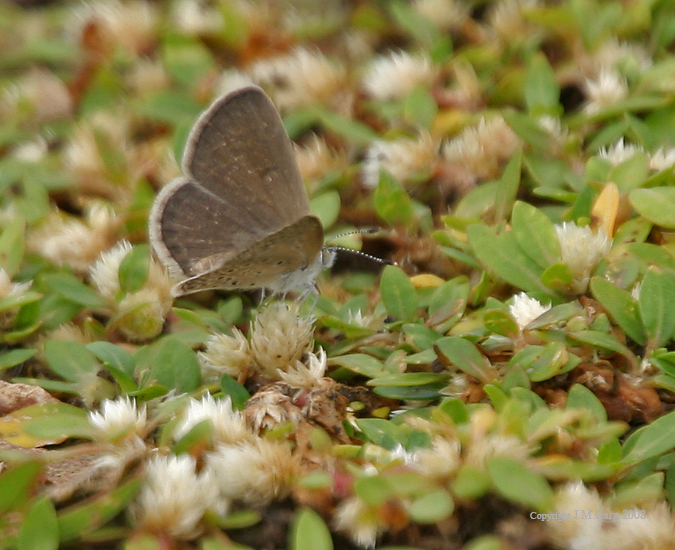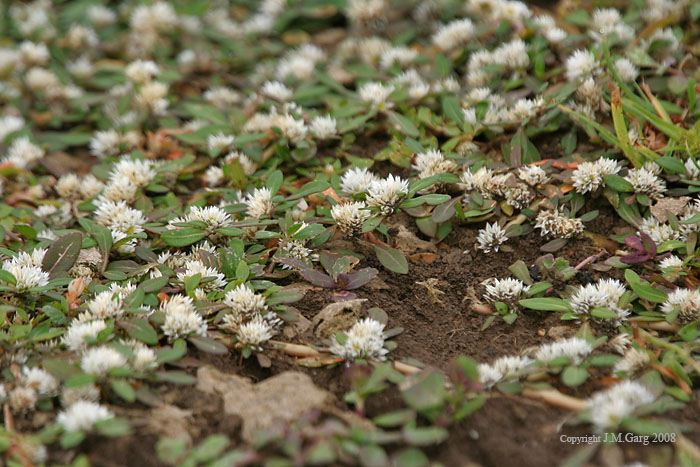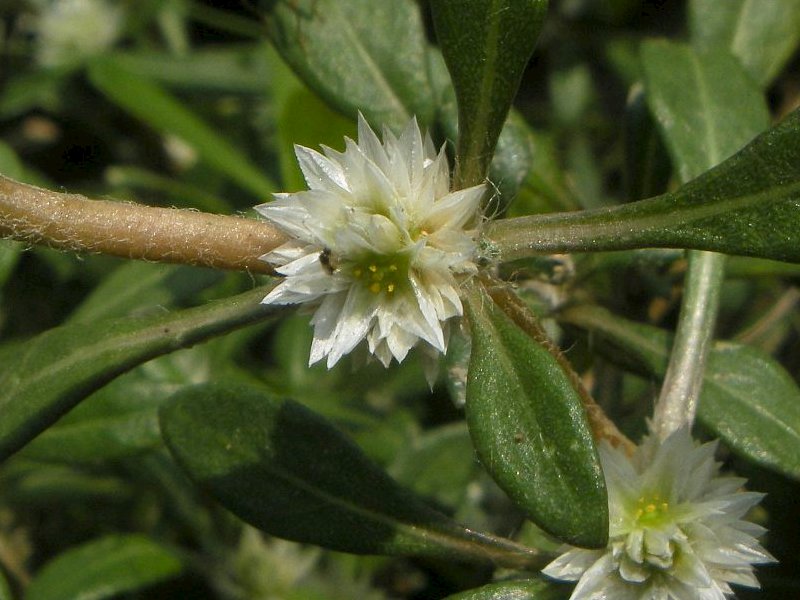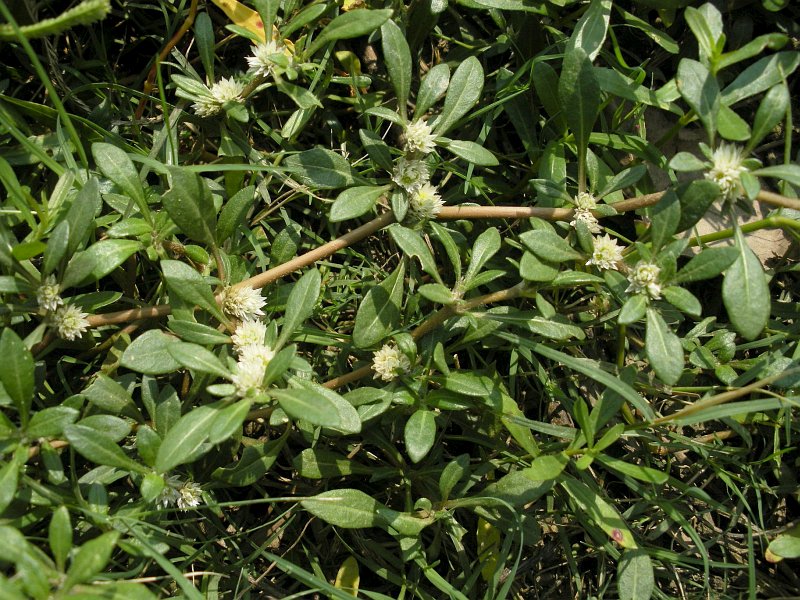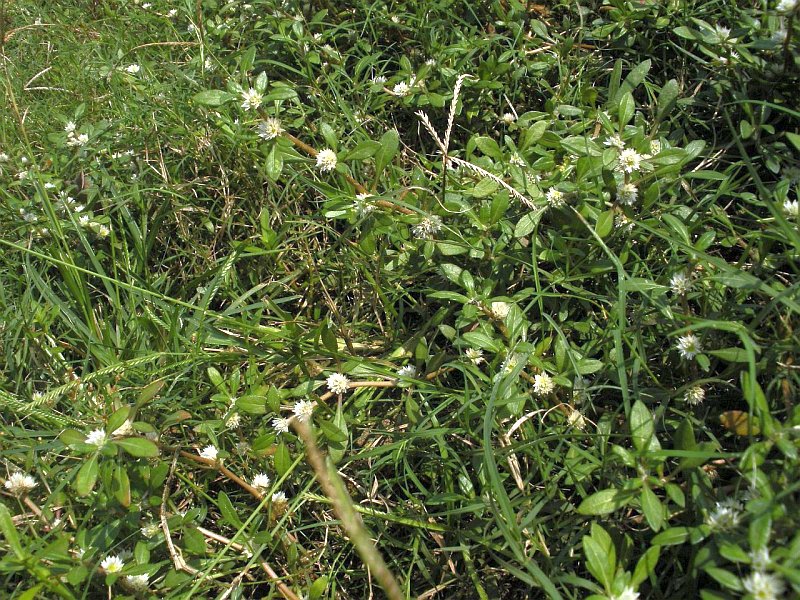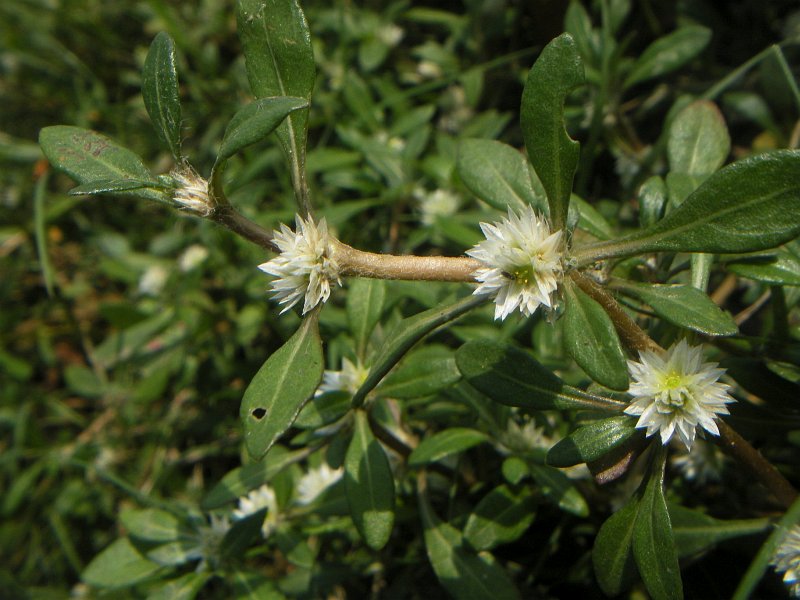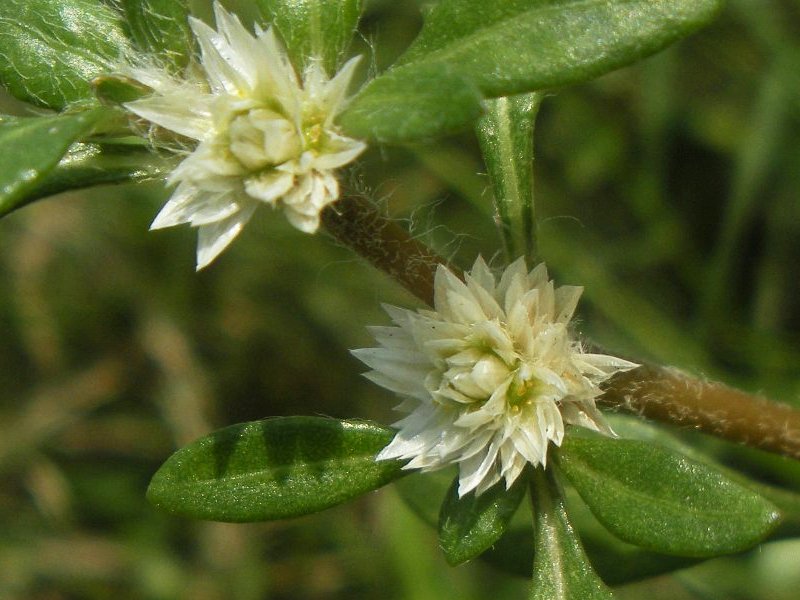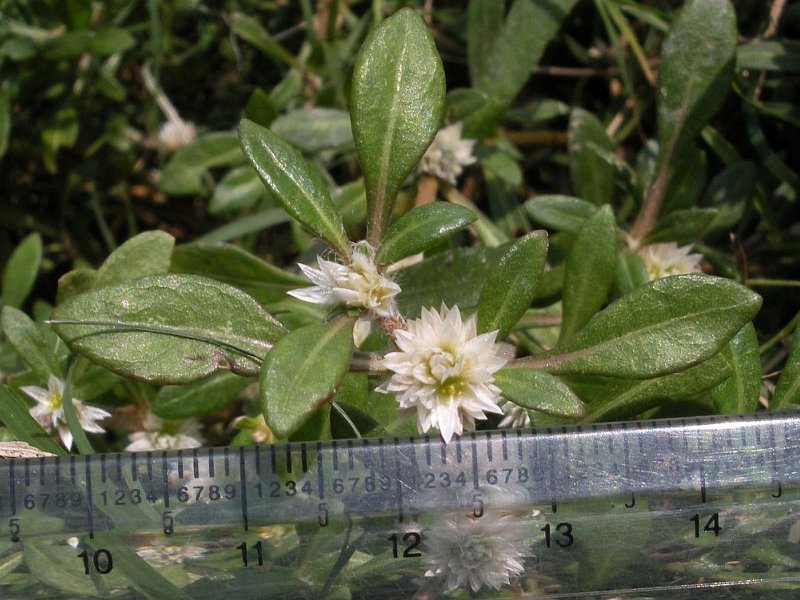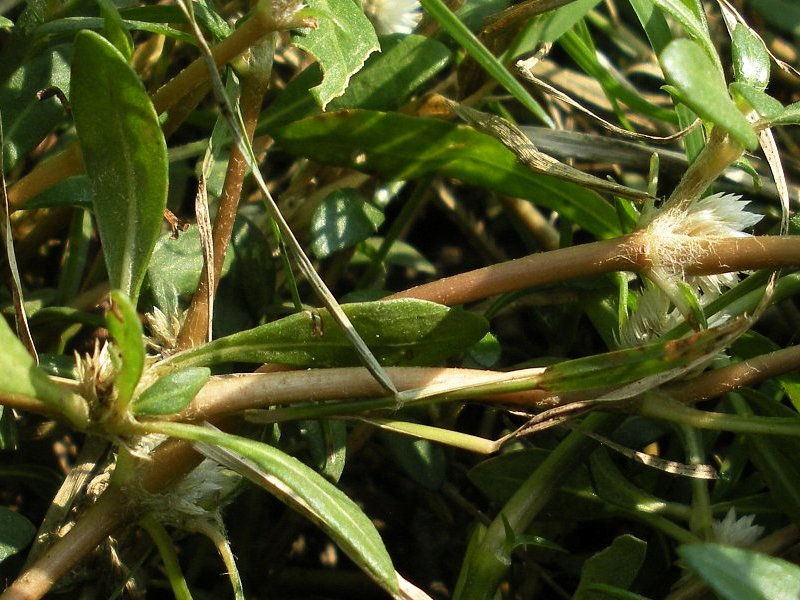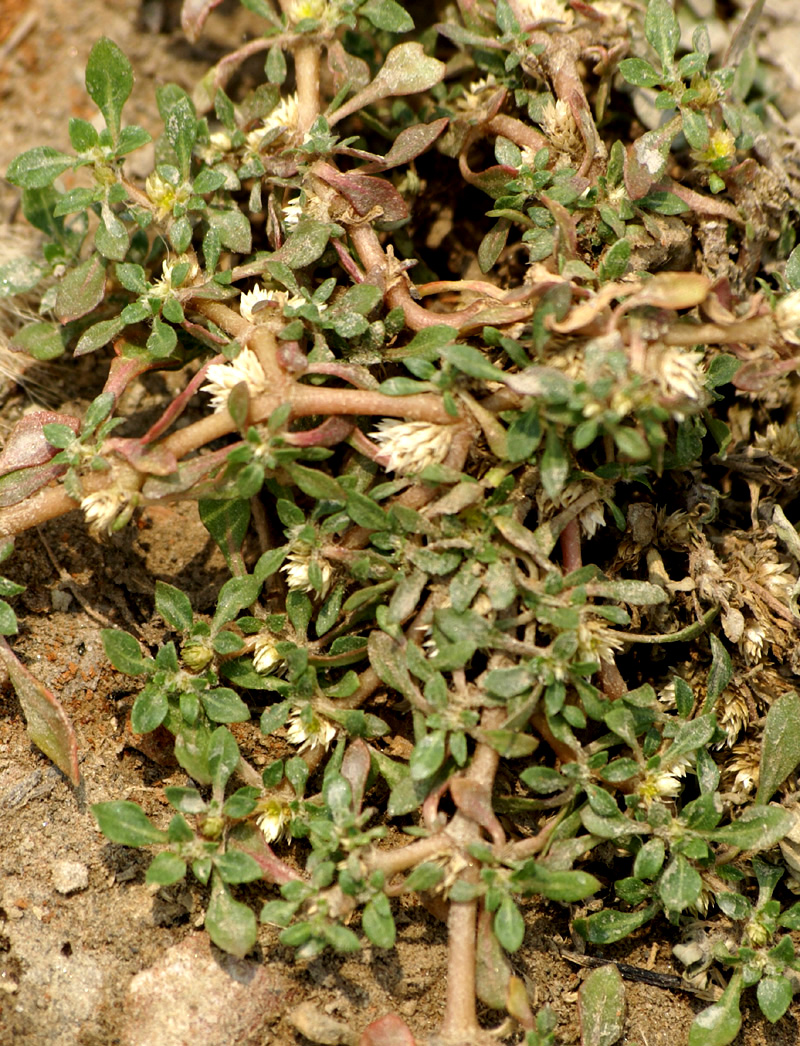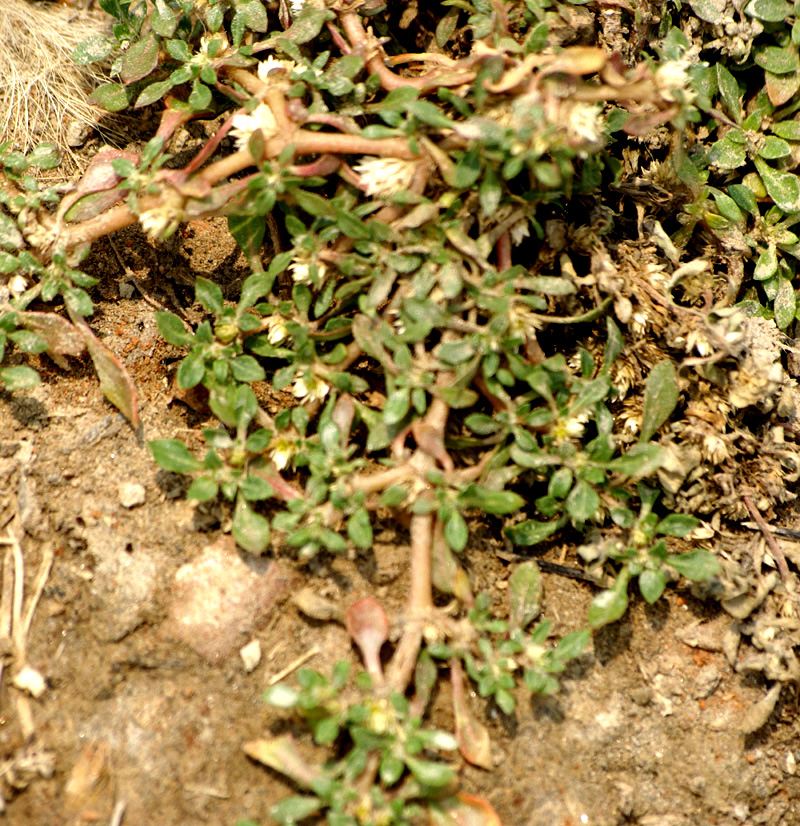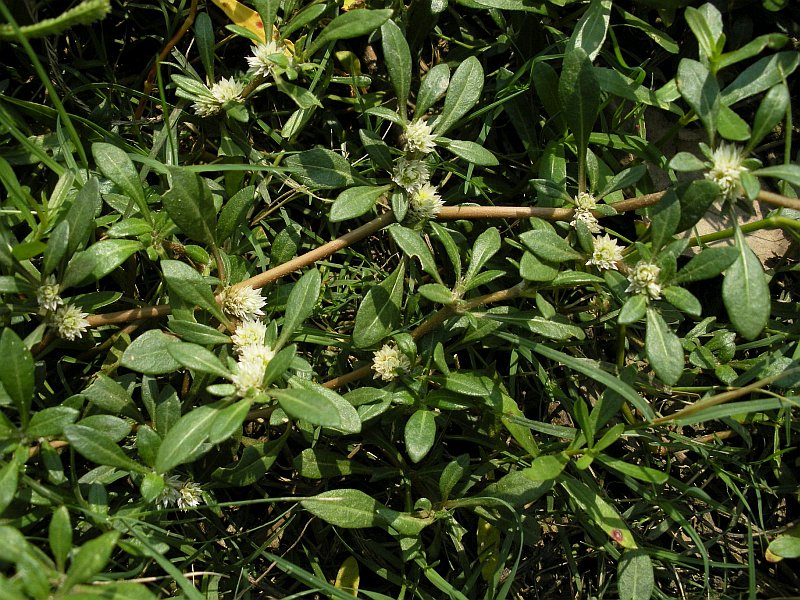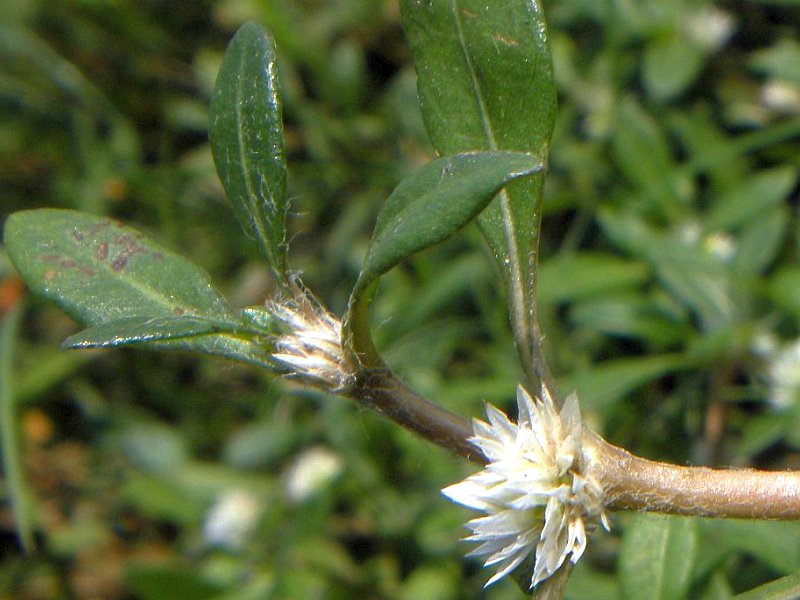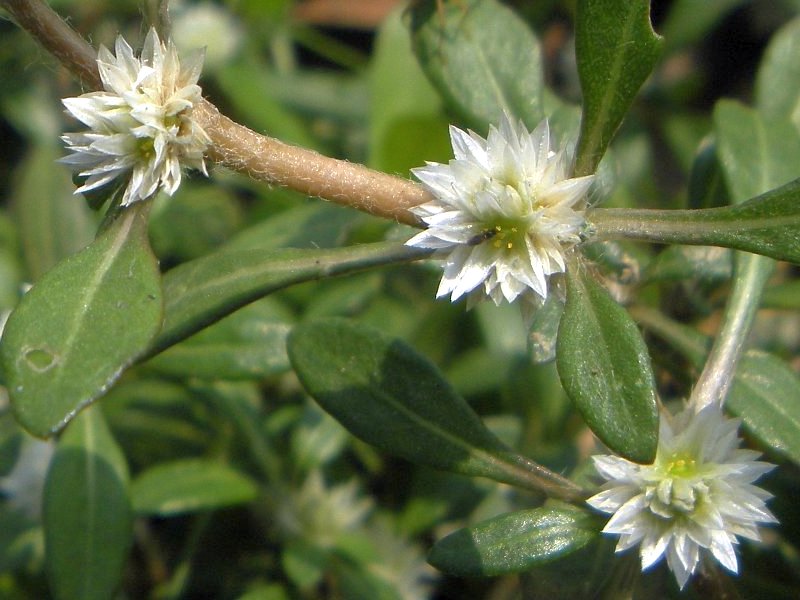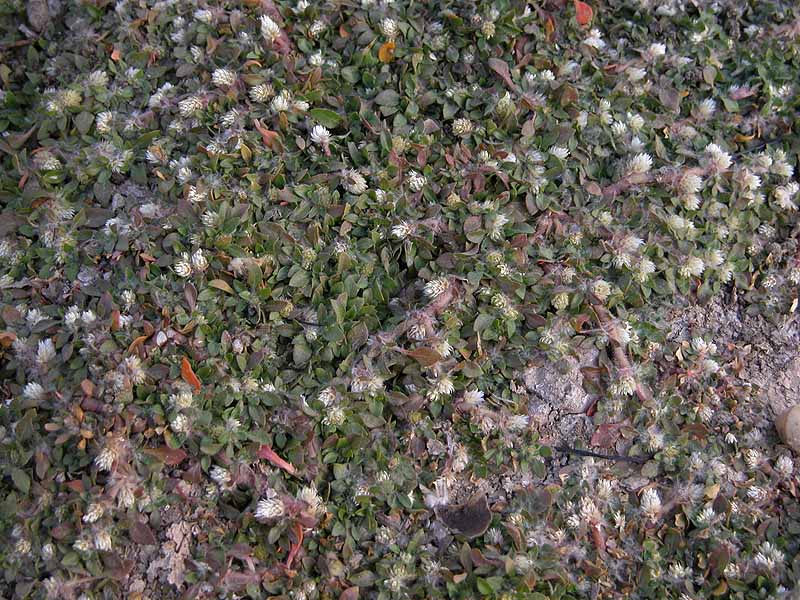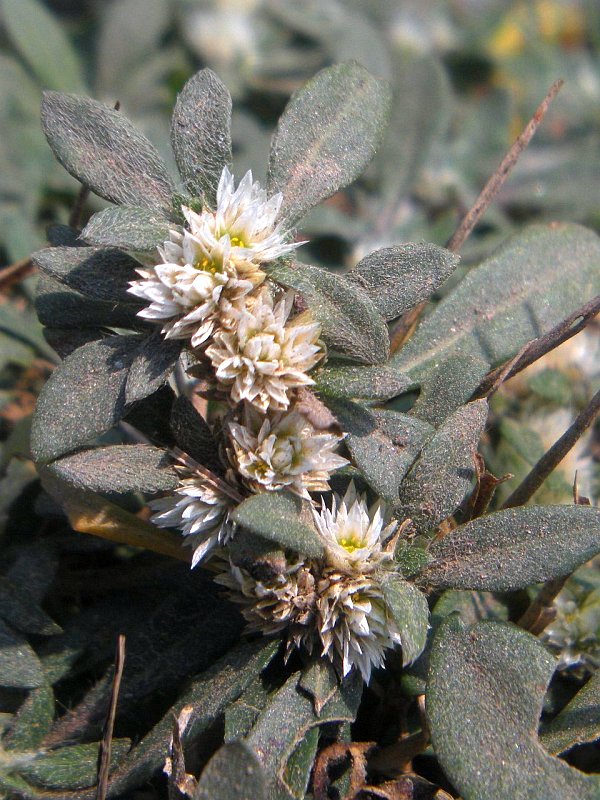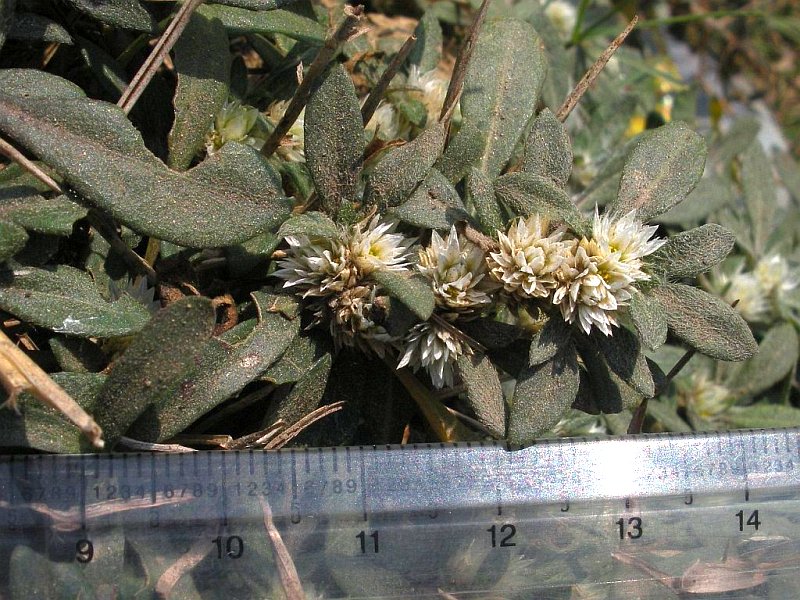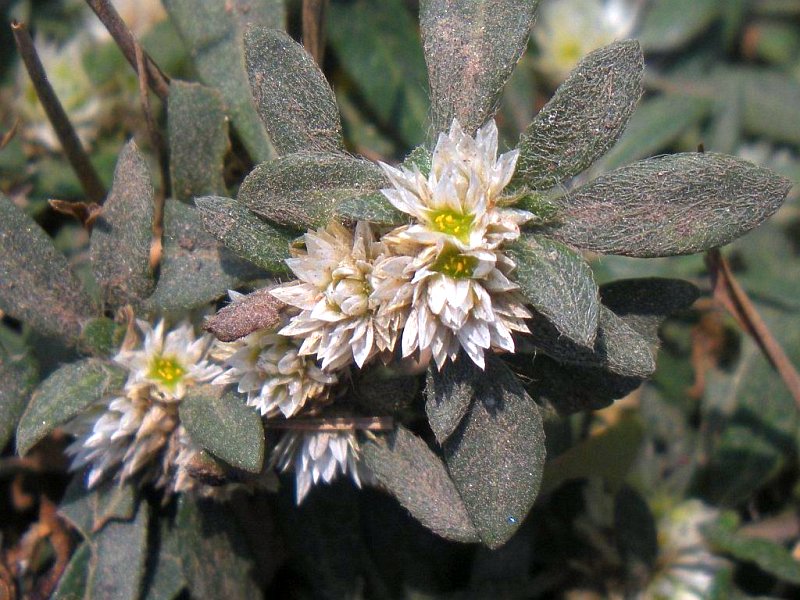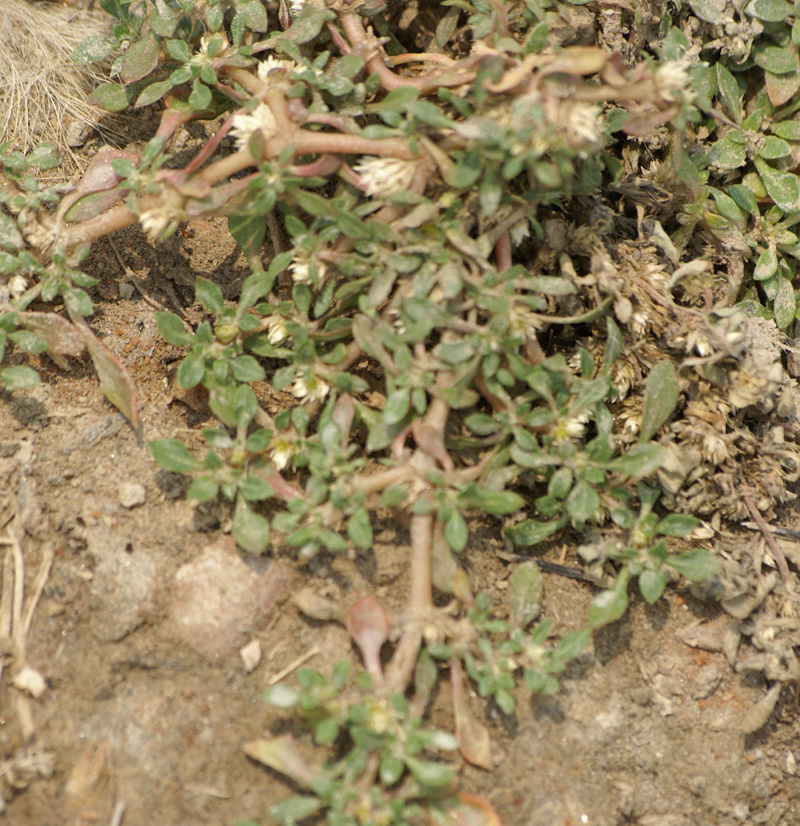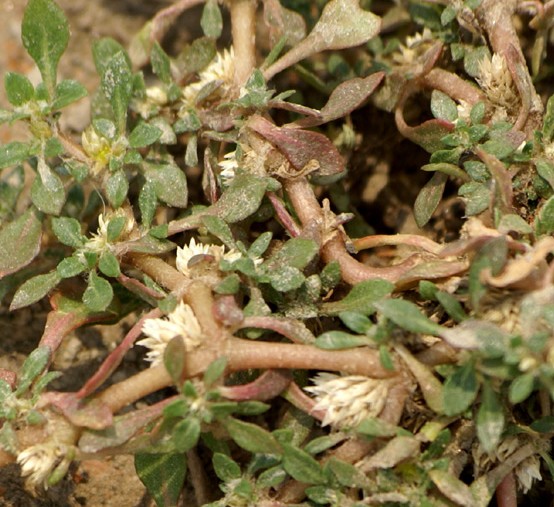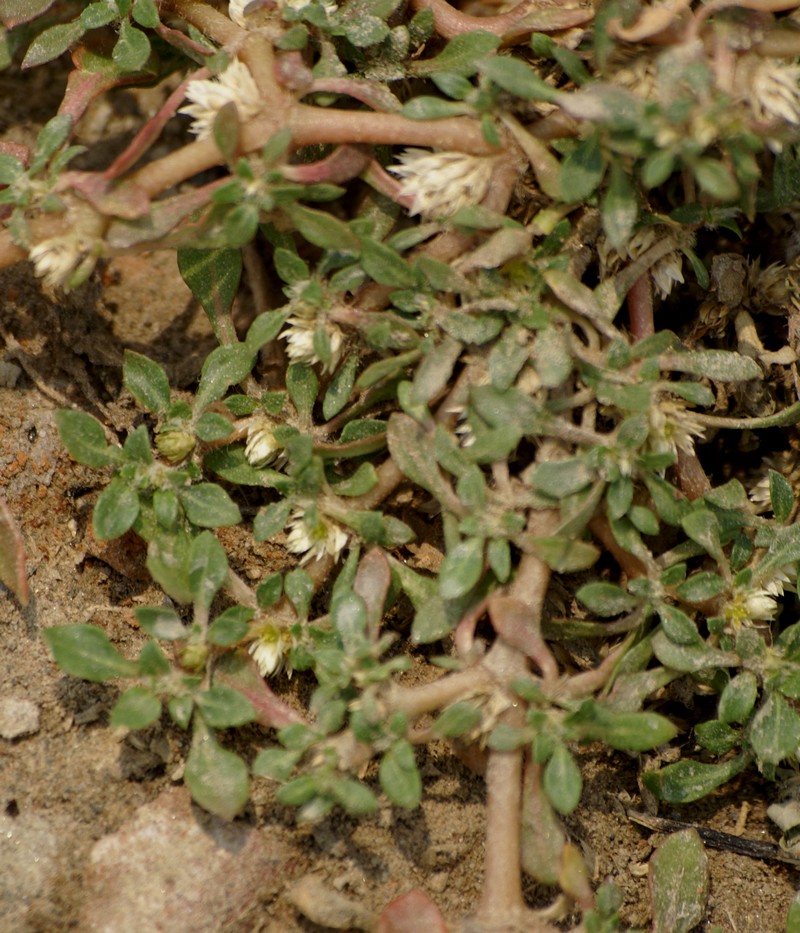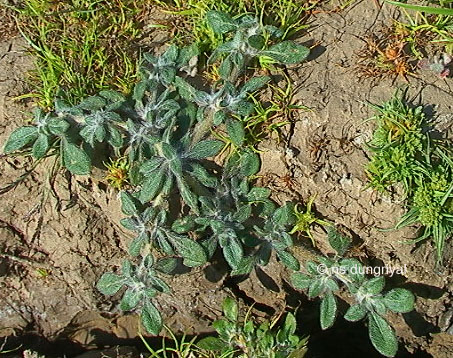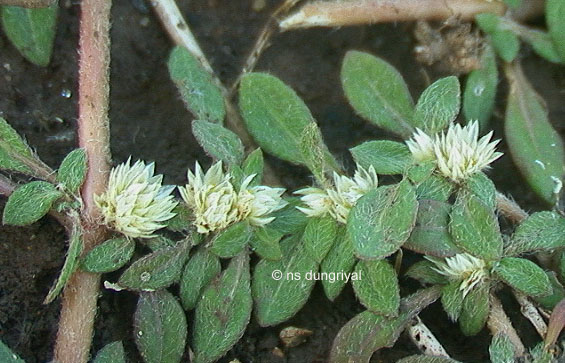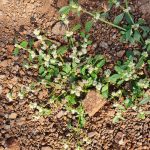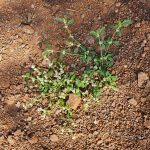Alternanthera paronychioides A.St.-Hil., Voy. Distr. Diam. 2(2): 43 1833. (Syn: Achyranthes chacoensis (Morong) Standl.; Achyranthes paronychioides Schinz [Invalid]; Alternanthera achyrantha var. angustifolia Mart. ex Moq.; Alternanthera amoena Back. & Sloot.; Alternanthera austrotrinidadis (Suess.) Pedersen; Alternanthera ficoidea (L.) R. Br. .; Alternanthera leucantha Moq.; Alternanthera paronychioides var. amazonica Huber …; Alternanthera polygonoides var. austrotrinitatis Suess. …….; Alternanthera virgata Spreng. ex Moq.; Bucholzia polygonoides (L.) Mart. .; Telanthera arenaria Casar. ex Seub. (Unresolved); Telanthera polygonoides var. brachiata Moq.; Telanthera polygonoides var. diffusa Moq.; Teleianthera manillensis Walp.);. . Smooth Chaff Flower; . Soft-stemmed prostrate perennial herb, hairy, later glabrescent; leaves elliptic, ovate-rhombic to spatulate, up to 2 cm long, hairy beneath; flower greenish-white in axillary sessile heads about 1 cm in diam; bracts less than half as long as tepals ; tepals similar, white, ovate-oblong, 3-5 mm long, acuminate, outer 3 3-veined, inner 2 1-veined; pseudostaminodes shorter than stamens, 3-4-toothed; utricle obcordate, brown. . Prostrate herb often confused with A. pungens from which its is very distinct in soft nearly fleshy branches, white-villous when young; leaves soft, covered with long hairs when young, mostly shorter than 2 cm, less than half as broad as long, lanceolate to elliptic-ovate; inflorescence nearly 5 mm across, tepals white, subequal without spiny tips. . A. paronychoides is a soft stemmed plant of wet grounds, often found along banks of drains, streams and river banks. It is totally creeping and rooting herb; . Alternanther paonychoides is, a much different plant, with delicate, smooth, creeping stems, and much smaller leaves; . Prostrate herbs, stem sparsely covered with crisped hairs. Leaves to 3 x 0.7 cm, oblanceolate to spathulate, apex acute, glabrous. Spike 5 x 3 mm, solitary, axillary, few-flowered, sessile; bracts and bracteoles similar, 1.5 mm long, hyaline, apiculate. Flowers densely packed; tepals 5, outer three larger, 2.5 x 1 mm, ovate, acute, inner smaller, all hairy; stamens 3-5; ovary obovoid, compressed, stigma bilobed. Flowering and fruiting: June-August Along lake beds when water recedes, also in wastelands Native of Tropical America, getting established in Tropical Asia Attributions- Dr. N Sasidharan (Dr. B P Pal Fellow), Kerala Forest Research Institute, Peechi) . For Id 230708JM2: I think you have taken pictures of Dark Grass Blue on Alternanthera paronychioides. The flowers of this exotic weed can be used in greeting card after being pressed and dried. Thanks, …, for Id help. Here are a few links for pictures & details of Alternanthera paronychioides (Smooth Chaff-flower): Picasaweb http://89sky.net/vbb/showthread.php?p=11624 Backyard Gardener http://www.efloras.org/florataxon.aspx?flora_id=600&taxon_id=242412161 After further checking the description of Alternanthera paronychioides given at http://www.efloras.org/florataxon.aspx?flora_id=600&taxon_id=242412161 with my pictures & pictures of Alternanthera paronychioides at http://89sky.net/vbb/showthread.php?p=11624, I feel my species is not Alternanthera paronychioides. It quite matches up with Alternanthera sessilis, posted earlier at Indiantreepix link. A.sessilis has linear leaves whereas your plant has orbicular or obovate leaves. The plant is A. pungens which is a native of Central America, naturalised in India. Another difference (you can see through a lens) between the 2 species is that the latter has spinescent heads and the tepals are dissimilar which is not so with A. sessilis. My book gives picture of A. sessilis which differs from yours. I do have a picture of A. pungens which tallies with yours. Here are a few good links with details & pictures of Khaki weed (Alternanthera pungens): HEAR & HEAR 2 Here are a few good links with details & pictures of Khaki weed (Alternanthera pungens): HEAR & HEAR 2 This plant from Hyderabad by … as per feedback in the thread has been wrongly labelled as A. pungens at FOI website. It doesn’t look like A. pungens. Yes surely Alternanthera paronychioides Alternanthera again from Hooghly 13/11/12 sk2: Species : Alternanthera paronychioides A.St.-Hil. ? H & H : prostrate herb, part semi erect, in a moist field Date : 13/11/12, 10.30 a.m. Place : Hooghly A. philoxeroides has flowers in heads on axillary long peduncles Thank you very much for introducing me to two more Alternanthera. I remember the discussion in my previous post. Alternanthera paronychioides A. St-Hill, Voy. Distr. Diam. 2: 439. 1833. Common name: Smooth joyweed Soft-stemmed prostrate perennial herb, hairy, later glabrescent; leaves elliptic, ovate-rhombic to spatulate, up to 2 cm long, hairy beneath; flower greenish-white in axillary sessile heads about 1 cm in diam; bracts less than half as long as tepals ; tepals similar, white, ovate-oblong, 3-5 mm long, acuminate, outer 3 3-veined, inner 2 1-veined; pseudostaminodes shorter than stamens, 3-4-toothed; utricle obcordate, brown. Photographed from Delhi. Now wondering whether have neglected it considering it to be stunted growth of common Alternanthera. Chenopodiaceae and Amaranthaceae Week : sk-13 : Alternanthera paronychioides A.St.-Hil.: Yes … Excellent photographs. Thank you very much Sir, once again. Chenopodiaceae and Amaranthaceae Week :: Alternanthera paronychioides Pune SMP5: Yes … Thanks for upload. Chenopodiaceae and Amaranthaceae Week : sk-03 : Alternanthera sp.: I think, based upon the keys at – efi thread, this species is also Alternanthera paronychioides A.St.-Hil. . Alternanthera paronychioides A. St.-Hil. = Alternanthera ficoidea (L.) P. Beauv. as per GRIN : 5 posts by 1 author. FLOWERING PLANTS OF INDIA, DICOTYLEDONS, Vol-I (Acanthaceae–Avicenniaceae) authored by S. Karthikeyan, M. Sanjappa and S. Moorthy and published by BSI, Kolkata in 2009 also does not mention it (Alternanthera paronychioides A. St.-Hil.). Pl. see Alternanthera. Yes, Karthikeyan et al.(2009) does not mention A. paronychioides A. St.-Hil. as they consider it a synonym of A. polygonoides R.Br. ex Sweet, which itself is mentioned as synonym of A. sessilis (L.) R.Br. ex DC. by The Plant List. Thus A. paronychioides A. St.-Hil. and A. polygonoides R.Br. ex Sweet becomes synonyms of A. sessilis (L.) R.Br. ex DC. But again Plant List considers A.paronychioides A. St.-Hil. as a distinct species with a specimen in Herbarium catalogue of Kew: (http://apps.kew.org/herbcat/getImage.do?imageBarcode=K000583029) which resembles to a species growing in India and identified as A. paronychioides A. St.-Hil. (particularly in Uttarakhand). I feel that A. paronychioides A. St.-Hil. and A. ficoidea (L.) Sm. are two different species. However, … Sir may have a better idea of it. May we have your views in the matter pl. I feel the two are too distinct to be merged. The specimens that I have collected/photographed leave no confusion. Thanks, … I will follow accordingly at efi site. Habit: Herb Habitat: Wild Location: Jessore Flowering: March Amaranthaceae, may be any Alternanthera sp. May be alternanthera pungens??? I think it is Alternanthera paronychioides A.St.-Hil. Chenopodiaceae and Amaranthaceae Week: RVS-1: Alternanthera paronichioides: Thanks … Any photograph with flowers? I only have a single picture of this, … thanks to the ‘time factor’! Enclosing a relatively closer view of flowers of this species. Though flowers are visible at lowest branching in … picture. Thank you … for showing another aggressive weed of Tropical and Subtropical areas in India. Enclosing a relatively closer look to flowers in this species. Nice to see the pattern of branching Alternanthera a big genus from the family.
Alternathera paronychoides from Delhi – efloraofindia | Google Groups . Alternanthera paronychioides from Delhi: Prostrate herb often confused with A. pungens from which its is very distinct in soft nearly fleshy branches, white-villous when young; leaves soft, covered with long hairs when young, mostly shorter than 2 cm, less than half as broad as long, lanceolate to elliptic-ovate; inflorescence nearly 5 mm across, tepals white, subequal without spiny tips. The plant is characteristic of frequently inundated habitats. Photographed from banks of Yamuna river in Wazirabad, Delhi. in July, 2009. This plant from Hyderabad by …. has been wrongly labelled as A. pungens at FOI website. . Wild Plant for ID : Nasik : 28APR21 : AK-24: 2 images. A tiny plant seen in grasslands. Gomphrena Species? Alternanthera ficoidea syn. tenella I too agree with … Yes from me also. Common here. It is a weed in the open land outside my house. I feel it is more closer to images at Alternanthera paronychioides rather than those at Alternanthera ficoidea Thanks for the correction.. . ?- ID Request – 270521AS02: 1 image. Could you please help me identify which plant is this? ——————- Date/Time- 20th May 2021, 8:45 am Location- Madhai, Near Satpura National Park, Habitat- Wild Plant Habit- Herb, found growing on a dry riverbed. Height/Length- 5 cm height Leaves Type/ Shape/ Size- Greenish red, simple leaves. Growing in opposite pairs. Flowers Size/ Colour/ Calyx/ Bracts- flower size was about .75 cm, very spiky in shape. Alternanthera paronichoides . Wild Plant for ID : Nasik : 06JUN21 : AK-03: 1 image. Alternanthera paronychioides . Identification help 5: 2 very high res. images. Check with Alternanthera pungens Thanks a lot. It’s generally taken as vegetable in our place and collected from wild. I think this is A.parinychioides as per images at . Confusion regarding Alternanthera species: I think A. sessilis only, A. paronychoides has more mat-forming habit and larger inflorescence. I think it should be Alternanthera paronychioides .. as pointed out by …!! The roots can be seen at every node.. Yes, it is
. References: efi thread The Plant List Ver.1.1 Flora of China Flora of Pakistan Annotated checklist of Flowering plants of Nepal USDA GRIN (Alternanthera paronychioides A. St.-Hil. Synonym of Alternanthera ficoidea (L.) P. Beauv.) Flowers of India India Biodiversity Portal Wikimedia Commons South China Botanical Garden Herbarium @ efloras.org Picasa Web Albums – ?????? – ?? Picasa Web Albums – ?????? – ?? |
Alternanthera paronychioides
Updated on August 31, 2025

